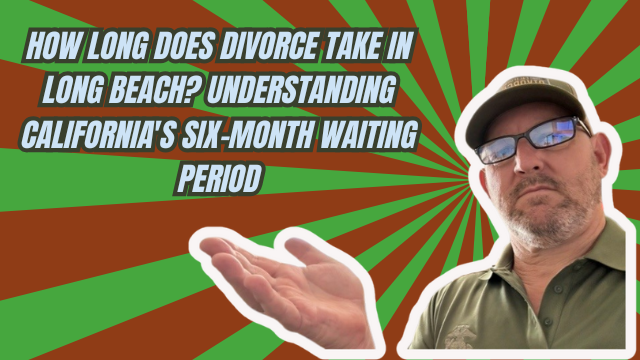How Long Does Divorce Take in Long Beach? Understanding California’s Six-Month Waiting Period
Did you know California requires a mandatory six-month waiting period for all divorces? That clock starts the moment your spouse is served with the petition or otherwise acknowledges receipt. Even if you complete every step of the paperwork right away, the court will not enter the final judgment until that six-month period has passed. The good news is you do not have to wait to start the process. You can file, serve, exchange disclosures, and finalize agreements early so your case is ready to wrap as soon as the clock runs out.
The Six-Month Waiting Period Explained
The law sets a minimum waiting period of six months from service or acknowledgement before a divorce can be finalized in California. This is a hard deadline: the court will not sign off on the judgment before that time. However, the waiting period does not block you from completing the rest of the divorce tasks. In fact, getting everything done early is often the smartest move.
When the clock starts
The countdown begins when either of these happens:
- Your spouse is formally served with the divorce petition
- Your spouse signs an acknowledgement of service
From that date forward you must wait six months before the judgment can be entered, even if you have already submitted all paperwork to the court.
How You Can Finish Everything Early
Rather than passively waiting, take a proactive approach. Here are the practical steps you can complete right away so your case is ready to finalize as soon as the waiting period ends:
- File the petition with the court
- Serve the other party or obtain acknowledgement of service
- Exchange mandatory financial disclosures
- Negotiate and finalize a settlement agreement or property division
- Draft and submit the proposed judgment and accompanying forms to the court
Completing these tasks early means your case simply sits until the statutory six months have passed, at which point the court can enter the judgment without additional delays.
A Real Long Beach Example
Here is a typical outcome when couples take a proactive route. A Long Beach couple filed and served in January. By the end of that same month they had exchanged disclosures, settled their issues, and we submitted the judgment to the court. Because the mandatory waiting period applies, their divorce will automatically finalize in July with no court appearances and no added stress.
This illustrates how efficient preparation eliminates unnecessary delays and minimizes friction during a difficult time.
Benefits of Preparing Early
- Saves time — You avoid months of uncertainty by completing everything as soon as possible.
- Reduces stress — No surprise court dates, no last-minute scrambling.
- Streamlines the process — Finalization becomes a simple administrative step after the waiting period.
- Avoids court appearances — Many uncontested divorces can finalize without anyone appearing in court.
- Predictable cost — Flat-fee pricing prevents surprise billing and helps you budget.
What We Offer to Help You Move Faster
We provide a full-service, flat-fee divorce solution for amicable couples across Los Angeles County. Our services include:
- Fast, court-approved electronic filings
- All-inclusive flat-fee pricing so there are no surprise charges
- 100 percent remote process so you can complete everything from home
- Guidance through disclosures, settlement drafting, and judgment submission
- Minimizing or eliminating court appearances when possible
If you want to complete your divorce as quickly and smoothly as the law allows, schedule a free consultation at divorce661.com. We will walk you through the process and help get your case ready so you only need to wait out the six-month statutory period.
Quick Checklist to Move Your Divorce Forward Fast
- File the petition and serve your spouse or obtain acknowledgement of service
- Exchange required financial disclosures
- Negotiate and finalize settlement terms
- Prepare and submit the judgment and supporting documents to the court
- Wait the mandatory six months from service, then the court can enter the final judgment
Take the first step today. By preparing early you can reduce stress, avoid unnecessary court time, and make the waiting period simply a formality before your divorce is finalized. To get started, visit divorce661.com and schedule your free consultation.

